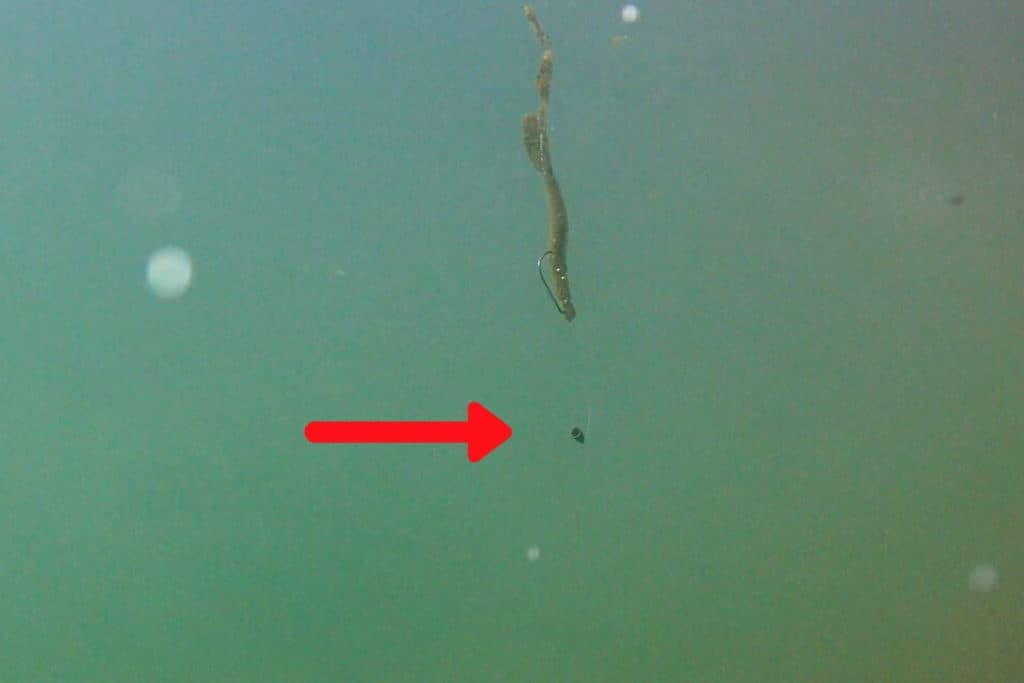If you want to be a bass angler, there are a few techniques that are a must-know. The Texas rig is one of them.
To Texas rig a soft plastic lure, insert the hook through the nose of the bait about ¼”. Then turn the hook so the point is positioned back towards the body of the lure. Bury the hook point in the plastic or rest it on top of the lure. Make sure the plastic lure is straight on the hook so it runs true in the water to eliminate line twist.
Bass anglers have relied on the Texas rig to bring their lures through all sorts of thick cover where bass hide. The technique has been around for many decades and for good reason – it works.
Origin of the Texas Rig
I am not sure if anyone knows the true history of the Texas rig, but there are a few common points of interest that most anglers reference when discussing the beginnings of this great presentation.
In 1949, Nick Creme invented the plastic worm. The Ohio native cooked up a batch of vinyl and molded it into a realistic and durable lure. The original Wiggle Worm sold in a 5-pack for $1. Soon the business took off.
Nick decided to move his fledgling company to the “heart” of bass fishing at the time in Tyler, Texas.
Anglers in the region tweaked and adjusted their presentations and eventually the Texas rig, as we know it, was developed. Bill Dance then popularized the technique in the 1960s after it was shown to him by fellow angler, Stan Marriott.
The Equipment for Texas Rigging
The Texas rig is a simple set up, but there are a few key components. Anglers will need a hook, worm weight, and some sort of soft plastic lure.
Hooks for Texas Rigging
There are many choices when it comes to hooks. As anglers grow in their skills and experience, using specialized hooks for different situations will become normal. Until then, hook choice can be a bit overwhelming.
The image below shows the different hooks that are typically used for Texas rigs.

Take note of the amount of separation from the eye of the hook to the hook point. Some designs, like the EWG, have the eye and the point of the hook in-line with each other. The flipping hook has a lot of separation between the two.
Each hook is designed for a specific purpose.
For example, an extra-wide gap or EWG hook, was created to handle thicker and wider body plastics. The extra gap makes for easier rigging when using something like a hollow-body tube or a large plastic swimbait.

The Weights for Texas Rigging
A slip-style egg sinker or worm weight has been the standard for a long time. Most anglers currently use some sort of worm weight with a conical shape. In recent years, tungsten weights have gained in popularity both because of local regulations against the use of lead and also because tungsten is a denser material. This creates a different and more pronounced clicking sound than softer lead weights.
The image below shows the variety of worm weights that are available to anglers.

Lures for Texas Rigging
This is a long list. Literally, any type of soft plastic lure can be rigged Texas style.
The whole thing started with the plastic worm, but the variety of plastics on the market today give anglers endless options. If it is plastic, it can be Texas rigged. Here is an article on choosing the right size lure for bass fishing.
The Step-by-Step Process for Texas Rigging in Photos

Pairing the Right Hook for the Size of the Lure
Without getting into too much detail, a safe starting place for most soft plastics is to select a hook that will take up the front ⅓ of the lure.
There are times that ratio will be a little more or a little less, but that will be a good starting point. A hook that is way too small for the plastic will hinder the hook-up ratio. A hook that is way too large will not stay rigged properly and can adversely impact the action of the lure.
For example, the tail on a soft plastic swim bait will not have the proper swimming motion if the hook reaches too far back towards the tail of the lure.
A safe bet is to size down before sizing up if you are not sure what hook to use. It is easy to retie a new one if the action or sink rate of the lure is not what you are wanting.
How to Choose the Right Weight for Texas Rigging
There are two ways in which an angler can think about weights and how they affect the lure.
First, is the sink rate or fall rate. Second is the speed at which the lure gets to the depth you want to target.
Fall Rate and Weight Selection
Let’s dive into fall rate.
As a general guideline, I like to have my soft plastics sink faster in clear water and slower in stained or muddy water.
When the water is clear, bass use their sight in conjunction with picking up vibrations through their lateral line. I have found that when the lures drop a little quicker, or flash in front of that bass suspended in a brush pile, I tend to elicit a reaction strike.
In dirty water I prefer to have a slower fall rate. The visibility of the bass is limited in these types of situations and feeling the lure through water displacement and vibration is key to finding their target.
With a slightly slower fall rate, it keeps the lure in front of the bass a little longer so they can zero in on it.
Adjust the weight you are using until you feel that the bite is dialed in to where the fish are more aggressive on the strike.
Depth and Weight Selection
There are times when the bass are just not hanging in shallow shoreline cover. Then anglers move to deeper structure or cover that may be below that fifteen or twenty foot mark.
If the bass are relating to the bottom, it is going to take an ⅛ ounce worm weight some time to get there. An angler is going to reduce the number of presentations they make in a day when all their time is spent waiting for the lure to get in position.
Increasing the size of the worm weight will put the bait in the target zone much faster and offer many more opportunities for a bite throughout the day. Using weights that are ¾ oz or larger is not unusual when fishing at deeper depths.

When to Peg the Weight and When Not To
By pegging the lure, I am referring to positioning the worm weight right above the plastic and holding it there so it does not slide up-and-down the line.
Anglers can use rubber t-stops, toothpicks, and sinker stops to peg their weight.
The only time I peg my weights is when fishing very thick and emergent vegetation with heavy worm weights. What can happen in this situation is the weight will slide through the vegetation while the soft plastic lure gets hung on the surface and will not “punch” through the weeds.
That is the perfect time to peg the weight to the hook so the lure follows through the thick cover.
In all other situations, I leave the worm weight to slide freely up-and-down the line.
Where to Throw a Texas Rigged Lure
The short answer is – anywhere.
With that said, Texas rigged soft plastics are excellent choices when fishing around cover.
This can include thick brush piles, around laydown trees, through weeds, around docks, or anywhere else you want the lure to remain weedless and not get snagged constantly.
Like I said, the Texas rig can be perfect anywhere.
How to Present a Texas Rigged Lure
There are three basic presentations anglers use when fishing Texas rigged plastics.
Swimming Retrieve
When using lures like soft plastic swimbaits, minnow imitations, or bluegill imitations, a swimming retrieve is used. Match the basic retrieve to the prey species you are trying to mimic.
Erratic movements, twitches, pauses, start-and-stop actions, all are more likely to draw the attention of a bass over a straight swimming presentation. Bass are opportunistic predators. When they see a potential meal that is struggling, wounded, or not quite acting right, their feeding instincts take over.
Fishing a Texas Rig on the Drop
There are many times when bass fishing where a straight, vertical drop is required.
This may be because there are bass suspended part way down dock pilings or you are dropping the lure through the middle of a tangle of brush.
The key to a successful vertical presentation is to allow the lure to drop straight down and not swim towards you, like it was a pendulum.
This means the lure should be presented with slack line allowing for a natural fall. If the line is tight, the action may be impeded and the lure will swing back towards you.
To get an idea of what a vertical drop looks like, practice in shallower water where you can see what is happening and how the lure is responding.
Dragging or Bottom Bouncing a Texas Rig
The best way I can describe this is to imagine what a crawfish would look like scooting along the bottom of a lake or river.
Use small movements of the rod to impart the action to the lure. Then reel up the slack line and continue. Pay close attention to what the bottom composition feels like or what type of cover you are dragging through.
When you get a bite, take note of where that bite came from so the location and type of cover or structure can be replicated.
What a Bite Feels Like on a Texas Rig
There are a couple of distinct feels to a Texas rig bite, depending on whether or not you are fishing with a swimming retrieve or a traditional bottom bouncing/dragging presentation.
When using a swimbait, paddletail, or another type of horizontally presented Texas rig lure, the bite is going to most often feel like weight. There may or may not be a thump, but the line will start to get heavy and not feel quite right.
When in doubt, set the hook.
If you are fishing the bottom of the lake or river, then there is a good chance you will feel a “bump.” It may not be much and if the bass is large enough, you may not feel anything at all when they inhale that lure like a vacuum pulling in dirt from a rug.
There are even times when you will notice your line swimming off in another direction.
Once again, if something doesn’t look or feel right, set the hook.
Savvy Texas rig anglers are also on the lookout for their line to stop sooner than it should. This is quite common when the bass inhale the lure on the drop. You may be fishing a dock sitting over twenty feet of water. The Texas rigged lure is dropped along the piling, but your line stops sinking well before that lure should have hit bottom.
Set the hook.
I catch lots of bass this way. Watching the line is an important part of bass fishing.
Matching a Texas Rig with the Correct Rod and Reel
The best rod really depends on the cover being fished. If you are dropping those plastics into real thick, gnarly, and nasty stuff a heavy power rated rod with a fast action will be ideal.
It will keep the head of the fish coming to the boat and not allow them to bury up deeper into the cover and then come off the hook.
If the cover you are fishing your Texas rig around is less dense, I like to use a medium-heavy power rated rod. There is still plenty of backbone to get the job done, but it is more forgiving when it comes to casting accuracy and angler fatigue.
As far as the reel goes, when fishing the bottom or thick cover, I prefer a high-speed reel. A gear ratio of 7.5:1 or 8.2:1 will be a perfect match for that rod.
When swimming a lure I opt for a gear ratio in that 6.2:1 range. It helps me to keep the lure presented a little slower.
Line Choice for Texas Rigs
There are a couple of factors to take into consideration – water clarity and the cover being fished.
In clear water, fluorocarbon and monofilament are the preferred choice. Fluoro sinks, is more durable than mono, and is less visible. On the downside, it is much more expensive.
Monofilament is a more cost-effective alternative in clear water, but there is a lot more stretch which can be problematic when pulling fish from heavy cover.
When there is some stain to the water or if it is muddy, braid is a great option. It is very strong, has little-to-no stretch, and lasts a long time.
I have also used braid in clear water with a fluorocarbon leader.
As far as pound test, the heavier the cover the heavier the line. It is not unusual to use braid in the 50lb test range or higher. When fishing clearer water, I have had great luck with fluoro in the 15-20lb range.
If I am fishing sparse cover, then dropping down to 12lb is something I do on a regular basis in ultra-clear water.
Final Thoughts
Fishing a Texas rigged soft plastic is something that all bass anglers either currently do, or will at some point.
It is one of those presentations that work all year and in any type of conditions.
Most bass anglers that have enjoyed the sport for a few years or more will have bags-upon-bags of soft plastics that are just waiting for the most versatile rigging system in the bass fishing world.
Be safe. Have fun and make sure to encourage someone today. You never know how you may change their life forever.
Isaiah 6:8

